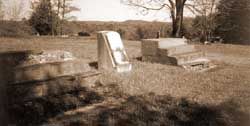Today is Sunday, the day of Christian worship and earthly rest. Yet during the Civil War, Sundays frequently serve other purposes in the name of the Kingdom of God.
With many Southern Baptists convinced that the Confederate States of America is God’s Kingdom on earth, church buildings and yards are frequently appropriated for the commissioning and blessing of men in arms. Sometimes, the intertwining of religion and patriotism takes places on the day of worship. Such is the case today at the Green River Baptist Church in Woodsonville, Kentucky, and the oldest church in Hart County (founded in 1803).
Gathered on the steps of the Green River Baptist Church are 84 new soldiers anxious to do battle against the northern enemy. The scene takes place in a border state that is not a part of the Confederacy, although many citizens of Kentucky choose to side with the South. Union armies are not far distant as the oath of enlistment is administered by Major William Preston Johnston, who is both the son of General Albert Sidney Johnston (commander of the Confederate’s western war department) and the nephew of General William Preston.
William Preston Johnston becomes a major figure in the months and years ahead, rising to the rank of Colonel and serving on the staff of Confederate President Davis from April 1862 through the end of the war. In May 1865, following General Robert E. Lee’s surrender at Appomattox, Virginia one month earlier, Johnston escorts the defeated and retreating Confederate Cabinet from Richmond to Georgia and is captured with Davis on May 10, 1865, near the small south Georgia community of Irwinville.
Today, though, Confederate hopes yet run high. The oath of loyalty to the Confederacy is duly administered to the soldiers gathered on the church steps who comprise the Lexington Rifles. John Hunt Morgan is elected as captain, and the company eventually becomes known as “Morgan’s Company,” named in honor of the man who becomes a famous Confederate calvary leader. Morgan has a connection with the Green River Church: he has been using the church as his headquarters while training his men.
The Lexington Rifles then march off to serve their southern nation, leaving behind a destroyed bridge over the Green River in order to prevent Union forces from using the rail line. At least three members of the Green River congregation leave their homes in order to fight for the Confederacy.
Yet in the weeks and months ahead, Green River Baptist remains on the stage of the raging conflict, for it is located near the critical juncture of the Green River.
In December 1861, Union forces press into the area. They quickly rebuild the bridge and construct Fort Craig, right behind the church, to help protect the crucial Louisville & Nashville Railroad. But in the give-and-take that characterizes much of Kentucky during the war, the Confederates return. In September 1862, on another Sunday – this one ill-fated – the fort and church building are destroyed during the Battle of Munfordville. The church is destroyed by retreating Union forces, in order to prevent Confederate snipers from using the facilities. Green River Baptist Church is destined to never be rebuilt. Confederate forces win the battle, yet the permanent destruction of the 59-year old Green River church in the fall of 1862 foreshadows the ultimate fate of the much-shorter lived Confederacy – destruction and ruin from which only memories will survive.
Sources: “Battle for the Bridge: Green River Baptist Church,” including photo (link); “Munfordville, Kentucky’s Civil War Heritage” (link); “Lexington Rifles” (link) and (link), including photo; Minutes, Green River Baptist Church, 1803 (link); Battle of Munfordville (link)



